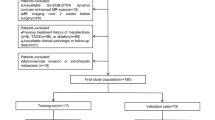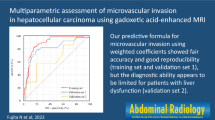Abstract
Objectives
Pretreatment evaluation of tumor biology and microenvironment is important to predict prognosis and plan treatment. We aimed to develop nomograms based on gadoxetic acid-enhanced MRI to predict microvascular invasion (MVI), tumor differentiation, and immunoscore.
Methods
This retrospective study included 273 patients with HCC who underwent preoperative gadoxetic acid-enhanced MRI. Patients were assigned to two groups: training (N = 191) and validation (N = 82). Univariable and multivariable logistic regression analyses were performed to investigate clinical variables and MRI features’ associations with MVI, tumor differentiation, and immunoscore. Nomograms were developed based on features associated with these three histopathological features in the training cohort, then validated, and evaluated.
Results
Predictors of MVI included tumor size, rim enhancement, capsule, percent decrease in T1 images (T1D%), standard deviation of apparent diffusion coefficient, and alanine aminotransferase levels, while capsule, peritumoral enhancement, mean relaxation time on the hepatobiliary phase (T1E), and alpha-fetoprotein levels predicted tumor differentiation. Predictors of immunoscore included the radiologic score constructed by tumor number, intratumoral vessel, margin, capsule, rim enhancement, T1D%, relaxation time on plain scan (T1P), and alpha-fetoprotein and alanine aminotransferase levels. Three nomograms achieved good concordance indexes in predicting MVI (0.754, 0.746), tumor differentiation (0.758, 0.699), and immunoscore (0.737, 0.726) in the training and validation cohorts, respectively.
Conclusion
MRI-based nomograms effectively predict tumor behaviors in HCC and may assist clinicians in prognosis prediction and pretreatment decisions.
Key Points
• This study developed and validated three nomograms based on gadoxetic acid-enhanced MRI to predict MVI, tumor differentiation, and immunoscore in patients with HCC.
• The pretreatment prediction of tumor microenvironment may be useful to guide accurate prognosis and planning of surgical and immunological therapies for individual patients with HCC.





Similar content being viewed by others
Abbreviations
- ADC:
-
Apparent diffusion coefficient
- CI:
-
Confidence interval
- CT:
-
Center of the tumor
- HBP:
-
Hepatobiliary phase
- HCC:
-
Hepatocellular carcinoma
- IM:
-
Invasive margin
- MVI:
-
Microvascular invasion
- T1D%:
-
Percent decrease in T1 images
- T1E :
-
Relaxation time on the hepatobiliary phase
- T1P :
-
Relaxation time on plain scan
- TIL:
-
Tumor-infiltrating lymphocyte
References
Tabrizian P, Jibara G, Shrager B, Schwartz M, Roayaie S (2015) Recurrence of hepatocellular cancer after resection: patterns, treatments, and prognosis. Ann Surg 261:947–955
Lim KC, Chow PK, Allen JC et al (2011) Microvascular invasion is a better predictor of tumor recurrence and overall survival following surgical resection for hepatocellular carcinoma compared to the Milan criteria. Ann Surg 254:108–113
Iwatsuki S, Dvorchik I, Marsh JW et al (2000) Liver transplantation for hepatocellular carcinoma: a proposal of a prognostic scoring system. J Am Coll Surg 191:389–394
Cucchetti A, Piscaglia F, Grigioni AD et al (2010) Preoperative prediction of hepatocellular carcinoma tumour grade and micro-vascular invasion by means of artificial neural network: a pilot study. J Hepatol 52:880–888
Palucka AK, Coussens LM (2016) The basis of oncoimmunology. Cell 164:1233–1247
Mahmoud SM, Paish EC, Powe DG et al (2011) Tumor-infiltrating CD8+ lymphocytes predict clinical outcome in breast cancer. J Clin Oncol 29:1949–1955
Brunner SM, Rubner C, Kesselring R et al (2015) Tumor-infiltrating, interleukin-33-producing effector-memory CD8(+) T cells in resected hepatocellular carcinoma prolong patient survival. Hepatology 61:1957–1967
Pagès F, Mlecnik B, Marliot F et al (2018) International validation of the consensus Immunoscore for the classification of colon cancer: a prognostic and accuracy study. Lancet 391:2128–2139
Gabrielson A, Wu Y, Wang H et al (2016) Intratumoral CD3 and CD8 T-cell densities associated with relapse-free survival in HCC. Cancer Immunol Res 4:419–430
Sun C, Xu J, Song J et al (2015) The predictive value of centre tumour CD8+ T cells in patients with hepatocellular carcinoma: comparison with immunoscore. Oncotarget 6:35602–35615
Garnelo M, Tan A, Her Z et al (2017) Interaction between tumour-infiltrating B cells and T cells controls the progression of hepatocellular carcinoma. Gut 66:342–351
El-Khoueiry AB, Sangro B, Yau T et al (2017) Nivolumab in patients with advanced hepatocellular carcinoma (CheckMate 040): an open-label, non-comparative, phase 1/2 dose escalation and expansion trial. Lancet 389:2492–2502
Sangro B, Gomez-Martin C, de la Mata M et al (2013) A clinical trial of CTLA-4 blockade with tremelimumab in patients with hepatocellular carcinoma and chronic hepatitis C. J Hepatol 59:81–88
Kurebayashi Y, Ojima H, Tsujikawa H et al (2018) Landscape of immune microenvironment in hepatocellular carcinoma and its additional impact on histological and molecular classification. Hepatology 68:1025–1041
Lee S, Kim SH, Lee JE, Sinn DH, Park CK (2017) Preoperative gadoxetic acid-enhanced MRI for predicting microvascular invasion in patients with single hepatocellular carcinoma. J Hepatol 67:526–534
Witjes CD, Willemssen FE, Verheij J et al (2012) Histological differentiation grade and microvascular invasion of hepatocellular carcinoma predicted by dynamic contrast-enhanced MRI. J Magn Reson Imaging 36:641–647
Kierans AS, Leonardou P, Hayashi P et al (2010) MRI findings of rapidly progressive hepatocellular carcinoma. Magn Reson Imaging 28:790–796
Ng IO, Lai EC, Ng MM, Fan ST (1992) Tumor encapsulation in hepatocellular carcinoma. A pathologic study of 189 cases. Cancer 70:45–49
Renzulli M, Brocchi S, Cucchetti A et al (2016) Can current preoperative imaging be used to detect microvascular invasion of hepatocellular carcinoma? Radiology 279:432–442
Banerjee S, Wang DS, Kim HJ et al (2015) A computed tomography radiogenomic biomarker predicts microvascular invasion and clinical outcomes in hepatocellular carcinoma. Hepatology 62:792–800
Kim H, Park MS, Choi JY et al (2009) Can microvessel invasion of hepatocellular carcinoma be predicted by pre-operative MRI? Eur Radiol 19:1744–1751
Kim KA, Kim MJ, Jeon HM et al (2012) Prediction of microvascular invasion of hepatocellular carcinoma: usefulness of peritumoral hypointensity seen on gadoxetate disodium-enhanced hepatobiliary phase images. J Magn Reson Imaging 35:629–634
Shields AF, Jacobs PM, Sznol M et al (2018) Immune modulation therapy and imaging: workshop report. J Nucl Med 59:410–417
Sun R, Limkin EJ, Vakalopoulou M et al (2018) A radiomics approach to assess tumour-infiltrating CD8 cells and response to anti-PD-1 or anti-PD-L1 immunotherapy: an imaging biomarker, retrospective multicohort study. Lancet Oncol 19:1180–1191
Ku YJ, Kim HH, Cha JH et al (2016) Correlation between MRI and the level of tumor-infiltrating lymphocytes in patients with triple-negative breast cancer. AJR Am J Roentgenol 207:1146–1151
Ku YJ, Kim HH, Cha JH et al (2018) Predicting the level of tumor-infiltrating lymphocytes in patients with triple-negative breast cancer: usefulness of breast MRI computer-aided detection and diagnosis. J Magn Reson Imaging 47:760–766
Dong Z, Huang K, Liao B et al (2019) Prediction of sorafenib treatment-related gene expression for hepatocellular carcinoma: preoperative MRI and histopathological correlation. Eur Radiol 29:2272–2282
Roayaie S, Blume IN, Thung SN et al (2009) A system of classifying microvascular invasion to predict outcome after resection in patients with hepatocellular carcinoma. Gastroenterology 137:850–855
Chen S, Feng S, Wei J et al (2019) Pretreatment prediction of immunoscore in hepatocellular cancer: a radiomics-based clinical model based on Gd-EOB-DTPA-enhanced MRI imaging. Eur Radiol 29:4177–4187
Choi JW, Lee JM, Kim SJ et al (2013) Hepatocellular carcinoma imaging patterns on gadoxetic acid-enhanced MR Images and their value as an imaging biomarker. Radiology 267:776–786
Rodríguez-Perálvarez M, Luong TV, Andreana L, Meyer T, Dhillon AP, Burroughs AK (2013) A systematic review of microvascular invasion in hepatocellular carcinoma: diagnostic and prognostic variability. Ann Surg Oncol 20:325–339
McHugh PP, Gilbert J, Vera S, Koch A, Ranjan D, Gedaly R (2010) Alpha-fetoprotein and tumour size are associated with microvascular invasion in explanted livers of patients undergoing transplantation with hepatocellular carcinoma. HPB (Oxford) 12:56–61
Peng Z, Jiang M, Cai H et al (2016) Gd-EOB-DTPA-enhanced magnetic resonance imaging combined with T1 mapping predicts the degree of differentiation in hepatocellular carcinoma. BMC Cancer 16:625
Mlecnik B, Tosolini M, Kirilovsky A et al (2011) Histopathologic-based prognostic factors of colorectal cancers are associated with the state of the local immune reaction. J Clin Oncol 29:610–618
Fridman WH, Pagès F, Sautès-Fridman C, Galon J (2012) The immune contexture in human tumours: impact on clinical outcome. Nat Rev Cancer 12:298–306
Funding
This study has received funding from the National Natural Science Foundation of China (No. 81971684, 81771908, 81801703) and the Guangdong Natural Science Foundation of Guangdong Province (No. 2018A030310282).
Author information
Authors and Affiliations
Corresponding authors
Ethics declarations
Guarantor
The scientific guarantor of this publication is Shi-Ting Feng.
Conflict of interest
Two of the authors (Tingfan Wu, Xin Li) are employees of GE Healthcare. The remaining authors of this manuscript declare no relationships with any companies whose products or services may be related to the subject matter of the article.
Statistics and biometry
One of the authors has significant statistical expertise.
Informed consent
Written informed consent was waived by the Institutional Review Board.
Ethical approval
Institutional Review Board approval was obtained.
Study subjects or cohorts overlap
Two hundred and seven study subjects have been previously reported in “Pretreatment prediction of immunoscore in hepatocellular cancer: a radiomics-based clinical model based on Gd-EOB-DTPA-enhanced MRI imaging” which has been published in European Radiology. This study is different from the previous one either in the objective or in the method.
Methodology
• Retrospective
• Diagnostic or prognostic study
• Performed at one institution
Additional information
Publisher’s note
Springer Nature remains neutral with regard to jurisdictional claims in published maps and institutional affiliations.
Supplementary Information
ESM 1
(DOCX 654 kb)
Rights and permissions
About this article
Cite this article
Tang, M., Zhou, Q., Huang, M. et al. Nomogram development and validation to predict hepatocellular carcinoma tumor behavior by preoperative gadoxetic acid-enhanced MRI. Eur Radiol 31, 8615–8627 (2021). https://doi.org/10.1007/s00330-021-07941-7
Received:
Revised:
Accepted:
Published:
Issue Date:
DOI: https://doi.org/10.1007/s00330-021-07941-7




